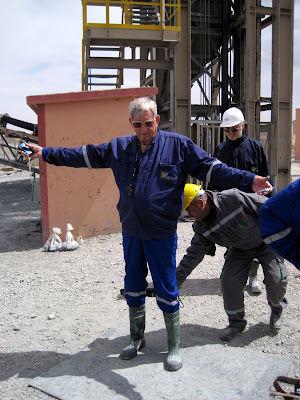We are near the end of the trip and we leave Skoura to return to Marrakech. On the way we stop in the lovely resort city of Ouarzazate (pronounced war-za-zat).
Interesting, in this basket of skin care and cosmetics there is a grey-black piece of galena (lead sulfide). The store owner said it was antimony. As mentioned before the Berber women used ground antimony sulfide as "kohl", eyeliner. Now they use the cheaper and more common and more toxic mineral galena. Indeed that mineral in the basket is galena.
Metalwork and Berber jewelry.
Continuing through the High Atlas towards Marrakech, this is Kasbah Ait Ben Haddou. It is a very famous Kasbah but we did not go inside as it looked very crowded.
We are taking the highway P1506 and it may be the nicest scenery we have had so far!
This is the Telouet Kasbah, built in the 19th century and owned until 1942 by the Glaoui Pasha (a.k.a. "Lord of the Atlas") and his family. The Pashas were powerful Berbers who got their titles from the Sultan, "Pasha" is similar to "Duke" or "Count". This kasbah was a resting place for Berber caravans traveling between Marrakech and the southern Sahara.
Storks nest on the Kasbah towers.
Lunch at a roadside cafe!
An argan oil shop. All argan products are made by a women's collective. The trees are rare, only grown in a limited region in Morocco. Women grind the nuts and extract the oil using traditional and modern techniques. The oil is used to make cosmetics and oil from roasted nuts is used for cooking. The oil has a nice flavor, sort of like sesame oil.
Back to Villas Chems Hamra in time for dinner, and Happy Birthday Eloïse!
Afterwards the groups break up, with some people returning home and other continuing their vacation in Fez. A wonderful trip with wonderful people!
Group 1: Mary, Bert, Kathy, Bruce, Edna, Dick, Mary, Georges, Dolores, Roy, Larry, Theresa, Bob, Mary, Tony behind the camera!
Group 2: Hassan (driver) Azziz (guide), Yusef (driver) Jean-Pierre (guide) Joanna, Pat, Jean, Dave, Bob, Conan, Jean, Esther, Linda, Alyssa, Bruce, Kathy, Mustapha (driver), Eloïse behind the camera!
We visit a spice and cosmetic store.
Interesting, in this basket of skin care and cosmetics there is a grey-black piece of galena (lead sulfide). The store owner said it was antimony. As mentioned before the Berber women used ground antimony sulfide as "kohl", eyeliner. Now they use the cheaper and more common and more toxic mineral galena. Indeed that mineral in the basket is galena.
Metalwork and Berber jewelry.
Continuing through the High Atlas towards Marrakech, this is Kasbah Ait Ben Haddou. It is a very famous Kasbah but we did not go inside as it looked very crowded.
We are taking the highway P1506 and it may be the nicest scenery we have had so far!
This is the Telouet Kasbah, built in the 19th century and owned until 1942 by the Glaoui Pasha (a.k.a. "Lord of the Atlas") and his family. The Pashas were powerful Berbers who got their titles from the Sultan, "Pasha" is similar to "Duke" or "Count". This kasbah was a resting place for Berber caravans traveling between Marrakech and the southern Sahara.
Storks nest on the Kasbah towers.
Lunch at a roadside cafe!
An argan oil shop. All argan products are made by a women's collective. The trees are rare, only grown in a limited region in Morocco. Women grind the nuts and extract the oil using traditional and modern techniques. The oil is used to make cosmetics and oil from roasted nuts is used for cooking. The oil has a nice flavor, sort of like sesame oil.
Back to Villas Chems Hamra in time for dinner, and Happy Birthday Eloïse!
Afterwards the groups break up, with some people returning home and other continuing their vacation in Fez. A wonderful trip with wonderful people!
Group 1: Mary, Bert, Kathy, Bruce, Edna, Dick, Mary, Georges, Dolores, Roy, Larry, Theresa, Bob, Mary, Tony behind the camera!
Group 2: Hassan (driver) Azziz (guide), Yusef (driver) Jean-Pierre (guide) Joanna, Pat, Jean, Dave, Bob, Conan, Jean, Esther, Linda, Alyssa, Bruce, Kathy, Mustapha (driver), Eloïse behind the camera!






























































